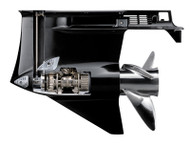The Truth About Props
Posted by Alan Jones on 1st Feb 2017
WHAT’S THE TRUTH?
We call props screws, and therefore many people suppose that a prop works just like a woodscrew. It’s seen as a helix that winds its way through water (instead of wood), using a continuous inclined plane for mechanical advantage. A variation is the Archimedes screw, which is like a woodscrew that spins in place, enclosed within a tube, and has been used throughout history to transport materials such as grain and water from one place to another. So this is how a prop works, right? It’s actually a lot more complicated than that.
Back in 1835, Francis Petit-Smith (along with other contemporary inventors such as John Ericsson) was convinced he could design a more efficient mechanism than a paddlewheel to move an engine-powered boat. One of his earliest designs was based on the Archimedes screw, but a fortuitous accident led to the discovery of the modern boat prop. During tests in 1837, his prototype wooden screw featured multiple turns and used a 6 hp engine to move a 30-foot-long canal boat at 4 mph. But when the screw’s vanes broke and left only a single turn intact, he was surprised to discover the top speed had increased to 8 mph.
So what happened? Unbeknownst to him, he had discovered the principle of “lift,” which would later make powered flight a possibility. The simple version is that when a prop spins, it acts as an airfoil that causes a pressure differential between the leading side of the blade and the underside. As the prop rotates, water is pushed away, and as water rushes in behind to fill this void, it’s concentrated in a smaller circumference, which makes it travel faster, providing rearward thrust. But the negative pressure on the leading side of the prop blade results in it being pulled along as well, so a prop is simultaneously pushing and pulling to help move a boat through the water.
Are stainless steel props are superior to aluminum props?
While stainless steel props do enjoy a number of advantages, aluminum props can be a better choice in a number of situations. First, there’s the cost: Stainless steel props can be four times more expensive than their aluminum counterparts, and while they offer better performance, it’s not as dramatic as you might think. One advantage often cited for stainless steel is that aluminum props flex more, which is true to a certain extent, but aluminum props are also made thicker to compensate. What probably has more effect is that stainless steel is stronger, so the blades can be made thinner and more hydrodynamic. For boats with a top speed around 50 mph, the speed difference is usually less than 2 mph.
Being lighter, aluminum props are superior when it comes to carrying around a spare prop, and because of the reduced mass, there is less of a clunking sound when you shift than with a stainless model. Being less dense than stainless steel makes aluminum props more vulnerable to damage when they hit something, but the cost of a repair is far less. Whenever I’m in a new area that features shallow, unmarked areas such as oyster beds, I put on my aluminum spare just in case. But if it’s a lake with lots of submerged trees, I’ll use the stainless steel, since it can slice through most sticks without being damaged. Although it’s been bandied about that running a softer aluminum prop might protect your gearcase from internal damage, this has never been conclusively proven. In fact, most props have rubber hubs, which help prevent lower unit damage, so the prop material is, for the most part, immaterial.
Are four and five-blade props only needed for rare circumstances?
While a vast majority of props are three-blade models, there are a number of boat owners who could benefit from using props with more blades. Notice I said boat owners, because not only do certain boats benefit from having more prop blades, but also the activities and load dictate the “proper” choice.
A good analogy for having more blades is wider tires on your car. More surface area provides more traction but also increases drag. Since four-plus-bladed props increase stern lift, they are useful for helping larger, heavy boats with deep-V hulls get on plane and run with less hull in the water for improved economy. But they are also good for bass boats and flats boats, which are relatively stern heavy and often use jack plates to reduce penetration of the lower unit in the water, so they can run in the shallows without touching bottom. Another valid use is to assist with better performance out of the hole when a boat is heavily loaded or is towing skiers. Rough-water performance is typically better with more blades, and cornering is also improved. The downside? Lower top speed (a couple of mph at best) and higher average prices are the biggest factors. How do you solve the prop-blade dilemma? Get two props to optimize your boat’s performance; you need a spare anyway.

